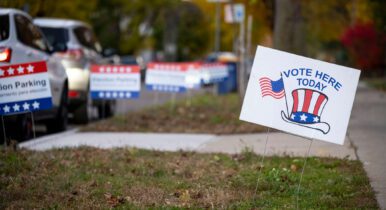A New Challenge for Campaigns: The ‘Passive’ News Consumers
Voters are relying more than ever on social media and algorithms to drive their news and political habits, putting the onus on campaigners and communicators to keep up.
That’s one of the main takeaways from an extensive new report from Democratic public relations and research giant Global Strategy Group and Navigator Research, which interviewed 12,000 registered voters on their news and media consumption habits.
The study found that, while most voters are regularly tuned into the news, roughly four in 10 aren’t. Rather, these voters wait for news content to find them on social media and are likely to verify or factcheck what they ultimately see.
The data holds key lessons for political communicators, who are facing a more challenging voter outreach and media landscape than ever. Platforms like YouTube and TikTok are playing an increasingly prominent role in voters’ media habits, and the demand for content is higher than it’s ever been.
But it’s not as simple as ensuring that your campaign or cause is showing up on social media feeds, GPG’s research found. Voters appear less concerned with audience size and more concerned about the authenticity and trustworthiness of social media accounts and content creators.
There are some key takeaways from GPG’s report.
A Lot of Voters Aren’t Actively Paying Attention
In an industry in which people are constantly dialed into the latest news, it’s easy to assume that voters are doing the same.
And while GSG’s survey found that most voters – 59 percent – say that they actively seek out news and information, a significant share – 41 percent – are “passive news consumers.” These voters aren’t hunting down news or making it a routine part of their days. They’re essentially waiting for news and information to find them.
What’s more, certain voting blocs are more likely to be passive news consumers. Fifty-three percent of independent voters, for example, fall into this category along with 56 percent of Gen Z voters, according to GSG’s study. On the flip side, active news consumers tend to be older and more partisan.
Perhaps unsurprisingly, passive news consumers are generally less engaged with politics. Only 16 percent of those voters described themselves as “very” politically engaged, compared to 38 percent of active news consumers who said the same.
All told, 51 percent of passive news consumers and 22 percent of active news consumers, respectively, said that they’re disengaged from politics.
Authenticity Matters More Than Reach
It can be tempting for campaigners to turn to social media channels that deliver huge audiences. Getting your message out to the most people possible seems like a no-brainer, right?
But GSG’s study found that a social media account’s number of followers is actually the least important factor for voters deciding what information to trust online. Forty-six percent of voters overall – including 48 percent of active news consumers and 44 percent of passive news consumers – said that they’re relying on follower-size to gauge their trust.
The biggest factor, according to GSG’s findings? Instinct.
Put another way, voters are trusting their guts when it comes to determining whether social media accounts or individuals are trustworthy or reliable. Seventy-seven percent of active news consumers are 72 percent of passive news consumers said that instinct was their most useful tool for sifting through content.
“Whether it’s a spokesperson, creator, or brand channel, tone and delivery often outweigh credentials,” GSG’s report reads. “Keep messaging human and conversational rather than overly polished or corporate.”
Working Within Algorithms
Active and passive news consumers tend to use social media at similar rates, the passives are generally less likely to see information on news and politics, with just 28 percent saying they frequently run into such content online and 49 percent reporting that they “sometimes” see it.
One possible explanation for that? Algorithms may be deprioritizing news and politics content for those users, according to GSG’s report.
That creates both a challenge and an opportunity for political communicators and campaigners. Most voters overall – 52 percent – are scrolling daily through their social media feeds, meaning they’re constantly running into algorithm-driven content that may or may not prioritize politics and news.
The key, according to GSG’s report, is to “adapt strategies to reach audiences who are primed to be less responsive to traditional messaging” Rather than aiming for uniformity in style and tone, the report argues that communicators would be better served by tailoring content to specific platforms, whether it’s YouTube, TikTok or Instagram.
“Trust travels with comfort,” the report reads. “Content appearing on familiar platforms gains implicit credibility.”



